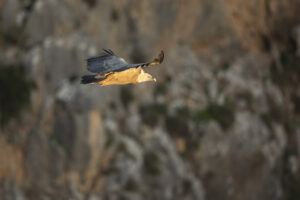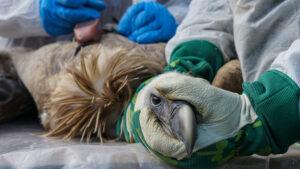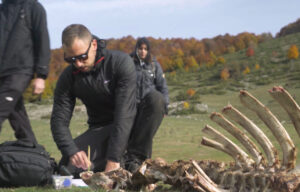The griffon vulture is an iconic and ecologically important species in the Central Apennines of Italy. Aided by new funding, the local rewilding team are working hard to support population growth.

Stepping up vulture conservation
The griffon vulture is one of Europe’s most impressive birds, with a wingspan of nearly three metres. It is also a keystone species, helping to recycle the carcasses of wild and domesticated herbivores. In the Central Apennines of Italy, where the species was reintroduced around 30 years ago, there are now around 64 breeding pairs. These are drawing growing numbers of wildlife lovers and nature enthusiasts to the area.
From late 2020, the Rewilding Apennines team have been working to support and enhance the griffon vultures of the Central Apennines, as part of efforts to support wildlife comeback and the development of a wilder, more functional landscape. These efforts have been helped by two grants – one of 130,000 euros from French philanthropic foundation Fondation Ensemble (which has its own vulture support measures) and one of 35,000 euros from the European Outdoor Conservation Association (EOCA) – a charitable foundation set up by a group of European outdoor companies to fund conservation initiatives.
Keeping track
Moving forwards, the new EOCA grant – which is titled “Improving the Circle of Life in the Central Apennines” – will support a range of actions. These will be carried out in partnership with the Carabinieri Forestali (forest ranger service) and protected area authorities, volunteers and local communities.

Following the tagging of 12 birds in October and November in the Monte Velino Nature Reserve – and ongoing tagging in early 2022 – 33 griffon vultures have so far been tagged with GPS transmitters by the Rewilding Apennines team and partners. The new grant will see this number increase to 45 by the end of 2023. The data collected from the transmitters – together with monitoring by camera traps and direct observation – will give the rewilding team a better understanding of the movement and behaviour of the birds, enabling more informed decisions to be made about their conservation.
From December to the end of February, the rewilding team are paying particularly close attention to the griffon vulture nesting site – a flat rock where the birds find a mate, make a nest, and eventually lay eggs in order to collect data useful for making a population estimate.
A safer landscape
The new grant will also see an increase in the number of patrols carried out by the Vulture Field Officer, together with volunteers and Carabinieri Forestali. This will make the Central Apennines rewilding landscape safer for vultures and all wildlife species by enabling the detection of poisoned animals and removal of contaminated carcasses. Poisoned baits and carcasses are frequently put out by farmers with the aim of killing foxes, wolves and other species that are seen as a threat to livestock. This can have a disastrous effect on vultures, which forage widely for such carrion.

The GPS tagging of vultures helps the monitoring team because the gathering of many signals in one place typically indicates the presence of a carcass, which can then be sampled to see if it is poisoned. Camera traps are sometimes placed at the location of carcasses to detect the presence of other scavengers and wildlife in general – this practice allowed the rewilding team to recently record the first ever confirmed sighting of a griffon vulture from Greece in the area. All wildlife sightings, carcass locations, instances of poisoning, and GPS data are logged in EarthRanger, enabling integrated monitoring.
This year the Rewilding Apennines will also engage in surveys of wind turbines and power lines to detect dead birds, estimate collision risks, and plan measures to reduce that risk.
Communal effort, communal benefit
In addition to direct conservation measures, the Rewilding Apennines team also plan to organise griffon vulture-related tours and events in the area. These will raise awareness of the ecological importance of the birds and the benefits they provide to local communities, which will help to build support and generate pride.
From a communal perspective, Rewilding Apennines Vulture Field Officer Nicolò Borgianni is keen to stress the wide range of stakeholders now involved in griffon vulture conservation in the Central Apennines.
“From police, park and veterinary authorities, and NGOs, to farmers, tourists, and tourism entrepreneurs, everyone is working together to protect and enhance the population of this majestic and important species. We not only want to reduce the threats that griffon vultures face, but ensure more people benefit from their presence too.”
Towards a wilder Central Apennines
The Central Apennines are a true biodiversity hotspot. This majestic range of limestone peaks, some of which reach heights of nearly 3,000 metres, are home to such iconic species as the Marsican brown bear, Apennine wolf, Apennine chamois, red deer and golden eagle – as well as the griffon vulture.
While many of these species are endangered or vulnerable, a decline in traditional agriculture and rural depopulation have seen some start to make a comeback in the Central Apennines of their own accord. To support this trend, the Rewilding Apennines team has been working to develop five strategically located wildlife corridors since 2018.